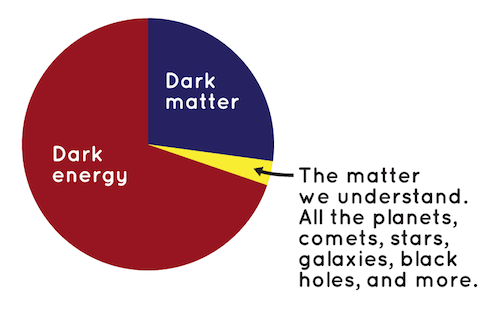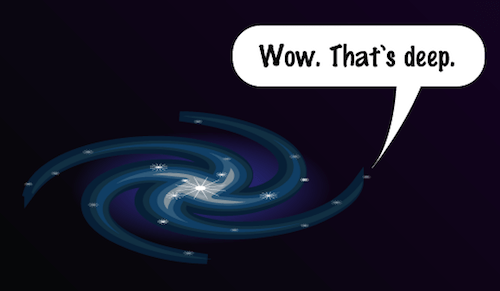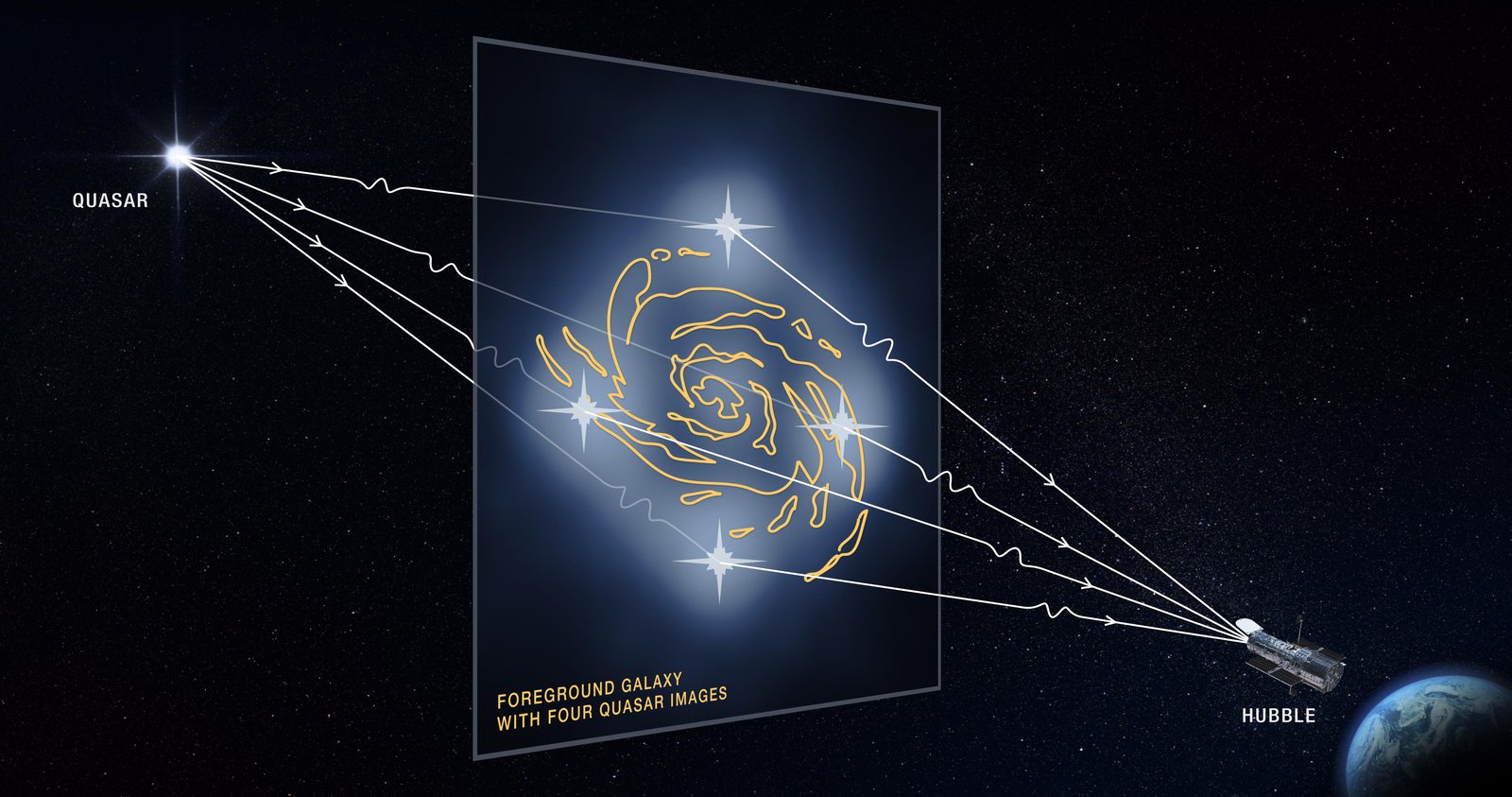This might be a surprise, but we don’t know what most of the universe is made of. Seriously, we don’t. You might be thinking, “But of course we do! It’s made of galaxies, stars, planets, black holes, comets, asteroids, and all the other cool space stuff!”
Yes, there is a lot of amazing space stuff that we know, but if we add it all up, it’s just a very small part of the entire universe. There’s a lot more out there. And we don’t fully understand what it is.

Credit: NASA/JPL-Caltech
But first, let us tell you a story about our universe.
For the first 150 million years after the Big Bang, there were no galaxies or stars or planets. The universe was just a soup of tiny, tiny things called particles. Gravity, the force that pulls you to the Earth and attracts all matter together, began to pull these particles toward each other.
As time passed, the first stars formed. Stars collected into galaxies. Galaxies began to cluster together. Those clusters are made up of the galaxies and all the material between the galaxies. Clumps of regular matter smashed into each other, and the planets in our solar system began to form around the Sun.
Stars rotate around the center of a galaxy, a little like planets around a star. Astronomers first noticed in the 1930s that some clusters of galaxies were spinning faster than they should be – if they contained only the stars, gas, dust and other material that we can see. There must be something else, something we can’t see, that adds gravity and acts like a glue so that the galaxies can spin so fast without flying apart. That something is dark matter.
Here’s another way you could think about it. Imagine you’re on a carousel, and you can balance just fine. If the carousel speeds up, you will have to grab onto a pole to pull yourself back in so you don’t fly off. That pole is like the dark matter, holding you in place in a rapidly spinning carousel.
In other words, something must hold our solar system, galaxies and clusters of galaxies together. Dark matter is that invisible glue that keeps stars, dust, and gas together in a galaxy. This mysterious substance makes up the majority of a galaxy's mass and forms the foundation of our Universe's structure.

Dark matter is still one of the greatest mysteries of science. Credit: NASA/JPL-Caltech
If dark matter is invisible, how do we know it’s there?
Because dark matter does not emit, absorb, or reflect light, we mostly know it is there because of its gravitational pull on visible matter in space. Think about it this way: Here on Earth, our planet’s gravity keeps us from flying out of our chairs, and the Sun’s gravity keeps our planet orbiting on a 365-day schedule. Because the Sun is the most massive object in the solar system, its gravity makes the planets, asteroids, and comets orbit around it. Objects that are further from the Sun orbit more slowly because they feel less of a pull from the gravity of our central star.
Our galaxy has about 100 billion stars, and our Sun is only one of them. The galaxy also has a lot of gas, where stars come from. All of these things rotate around the center of the galaxy. If there weren’t anything else in the galaxy besides stars, planets, and gas, the stars farthest from the center would rotate more slowly than the ones closer to the center. But telescopes have found that this is not true. Stars farther away actually rotate faster. The only way scientists can explain this is if there is a lot of dark matter.

Something strange and mysterious creeps throughout the cosmos. Scientists call it dark matter. It is scattered in an intricate web that forms the skeleton of our universe. Dark matter is invisible, only revealing its presence by pushing and pulling on objects we can see. NASA’s Roman Space Telescope will investigate its secrets. What will be revealed? Credit: NASA/JPL-Caltech
Wait, but what is dark energy?
When scientists study our universe, they see that it’s expanding. But if the universe is only made of the galaxies, stars, planets, and other things that we know about, it shouldn’t be expanding so fast. Something else is out there. There must be something that is making the universe expand faster and faster. We just don’t know what this energy is. We also don’t know where it comes from. But we can tell that it’s there. Scientists named this stuff “dark energy”.
We don’t know much about dark energy, but we do know there is a lot of it. Dark energy makes up 68%, about two-thirds, of the universe.

This galaxy is right… Dark matter is pretty weird! Credit: NASA/JPL-Caltech
Just like dark energy, we don’t know a whole lot about dark matter. But it seems that 27% of the universe, or about one quarter, is made up of the mysterious stuff.
Together, dark energy and dark matter make up 95% of the universe. That’s almost the whole universe! That only leaves a small 5% for all the matter and energy we know and understand. Energy like light, heat, and X-rays, together with matter like people, elephants, planet Earth, the Sun, and all the galaxies only makes up 5% of the universe! That’s not very much.
How does NASA investigate dark matter?
Because scientists can't see dark matter directly, they have found other ways to investigate it. We can use indirect ways to study things, like looking at a shadow and making a guess about what's casting the shadow. One way scientists study dark matter is by using something called gravitational lensing.
Light going through a gravitational lens gets bent. When light from distant stars passes through a galaxy or cluster, the gravity of the matter present in the galaxy or cluster causes the light to bend. As a result, the light looks like it is coming from somewhere else rather than from its actual origin. The amount of bending helps scientists learn about the dark matter that is there. Many NASA scientists use the Hubble Space Telescope to observe gravitational lensing.

This graphic illustrates how a faraway quasar (an extremely bright region in the center of some distant galaxies) is changed by a big foreground galaxy. The galaxy's powerful gravity warps and magnifies the quasar's light, producing four warped pictures of the quasar. Credit: NASA, ESA and D. Player (STScI)
Dark matter and dark energy raise some of the biggest questions in the study of space and physics. Lots of scientists are using observations and math to figure out what these are. This will help us understand more about our amazing universe, where there is always more to explore, discover, and learn. In a few years, NASA will be launching a telescope called the Nancy Grace Roman Space Telescope, named after astronomer Nancy Grace Roman, to learn more about dark matter and dark energy. It will measure the bending of light from hundreds of millions of galaxies, and measure the movement of tens of millions of galaxies, making it a great tool for studying the unknown 95% of the universe.








